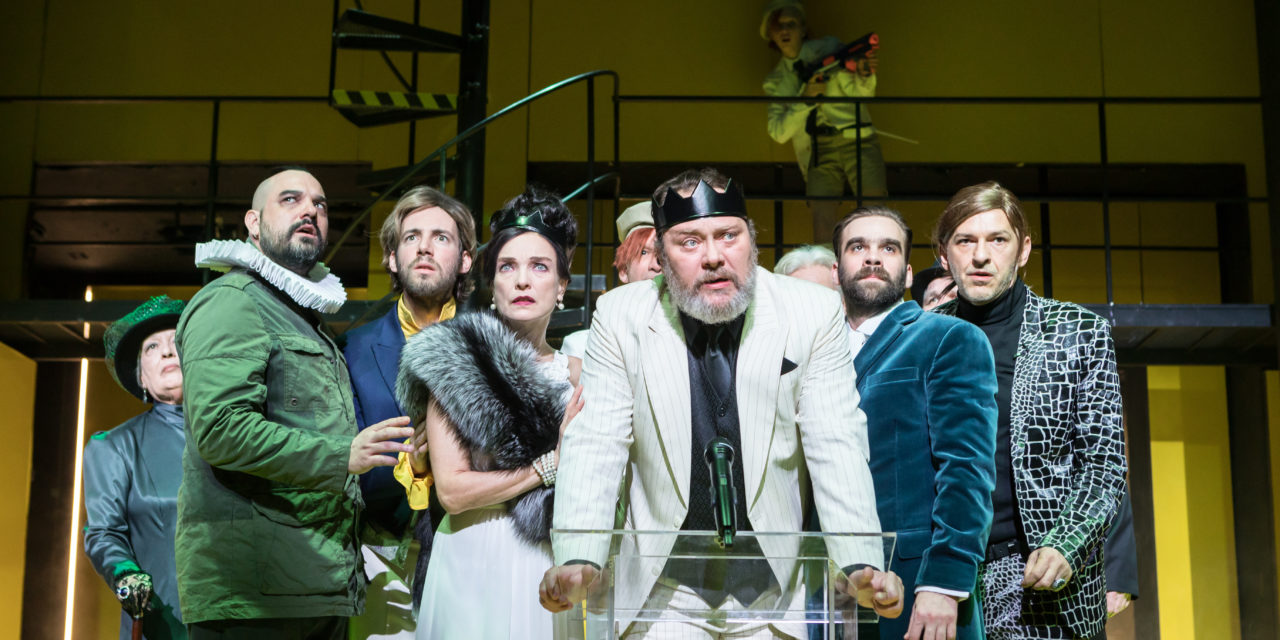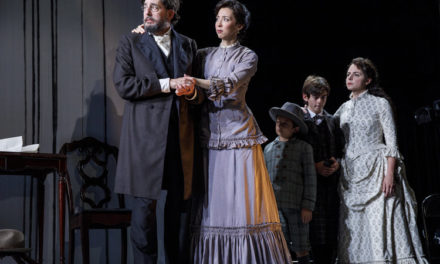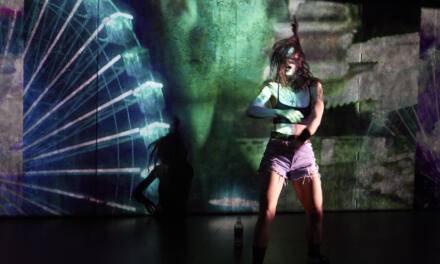Shakespeare’s history play revolves around a strange creature, the monster of power. Yet it poses a monstrous challenge with every production since it is full of historical characters, whose complex relationships, past grievances and familial connections prove difficult to understand for a contemporary (non-British) audience. Hungarian audiences of this performance, directed by Andrei Şerban, were helped by an informative chart of the Houses of York and Lancaster, illustrated by the actors’ photos in the foyer of the Radnóti Theatre. Still, for most spectators in present-day Budapest, the play’s whirligig of characters rather recalls watching an episode of Game Of Thrones without any previous knowledge of either cast or backstory.
Ever since Richard III was first performed in Hungary in the 1840s, it has often represented something more than merely a thrill of monstrous darkness, murder, and betrayal: it has become one of the most politically charged performances. This interpretation intensified after 1948–the beginning of the 40 years of Communist power–using the historical allegory to criticize a current tyrannical regime. It seems that in 2018, in an era characterized by populist leaders such as Trump and Orbán, the play has new political resonances, which the (Romanian-born) American director, Andrei Şerban, did not shy away from exploring.
Apart from the fury of mutual hatred and shifting political power, Shakespeare’s play has most often been considered a tragedy, with Gloucester at the center. However, the emphasis changed in the later 20th century, especially in Central and Eastern Europe: Jan Kott pointed out how the play represents the “Grand Mechanism” of political power, while theorist István Géher called attention to the victorious but finally destructive emptiness of Gloucester as the consummate actor. Guest director Andrei Şerban’s directorial concept balances between these two points of interpretation. Şerban, known for his reshaping of classics, and actor Róbert Alföldi (and former artistic director of the National Theatre in Budapest) in the title role, lead the way to a politically and theatrically significant performance of Richard III, supported by a talented cast of actors. The costume design assists the 21st-century Hungarian audience intelligently, in finding their way among the flurry of 15th-century English aristocrats, all of them murderous, vengeful and power-hungry. Visually they are divided into two easily identifiable parties. The anti-Richard faction is characterized by gaudy yellow colors, accessorized with a character-specific item of clothing: for instance, Lord Rivers (Ádám Porogi) sports an oversized flamboyant yellow cravat–and a funny French accent. Richard’s rise to the throne, on the other hand, coincides with the encroaching dominance of black and dark colors. His immoral followers, Ratcliff (András Rusznák) and Catesby (Ádám Porogi), appear as sadomasochistic sex offenders, in black fishnet wife-beaters and leather trousers.
The symbolic use of color remains coherent throughout, supported by the set design, which consists of simple lines, geometric forms and a raised platform with a narrow winding staircase, made of steel. The walls are bathed in yellow, the symbol of power before Richard’s triumph, but yellow is superseded by red in moments of violence. Gloucester (Róbert Alföldi) changes his sleek and glossy, snakeskin-like white-and-black suit to a black one after he becomes king. However, even the new black suit retains the snakeskin design in black, with the scaled pattern occasionally flashing in the harsh spotlight. One rather suspects than sees the scales, partly hidden by the blackness of the suit, which illuminates Richard’s flexibility of character, his suppleness to adapt himself to meet the demands of each new situation, and alludes to the biblical evil in the Garden of Eden.
After his rise to the throne, Richard paints his face yellow. This powerful theatrical gesture signals his growing alienation from human nature and simultaneously takes him closer visually to what he has been called by the others: a monster, a demon, a toad. Such verbal and visual associations are strengthened by the sounds heard during his soliloquies, addressed to the audience. The monologues of “the poisonous hunch-backed toad” are accompanied by the sound of dripping water; then, as we progress in time, the imaginary puddle, created by the water drops in the spectators’ minds, becomes a toad-infested swamp, evoked by the insistent loud croaking of invisible animals. Richard emerges as King of the Toads, surrounded and supported by these sounds, with his yellow face both captivating and abhorrently inhuman, and moving his body in a cramped, stiff, yet fluid manner.
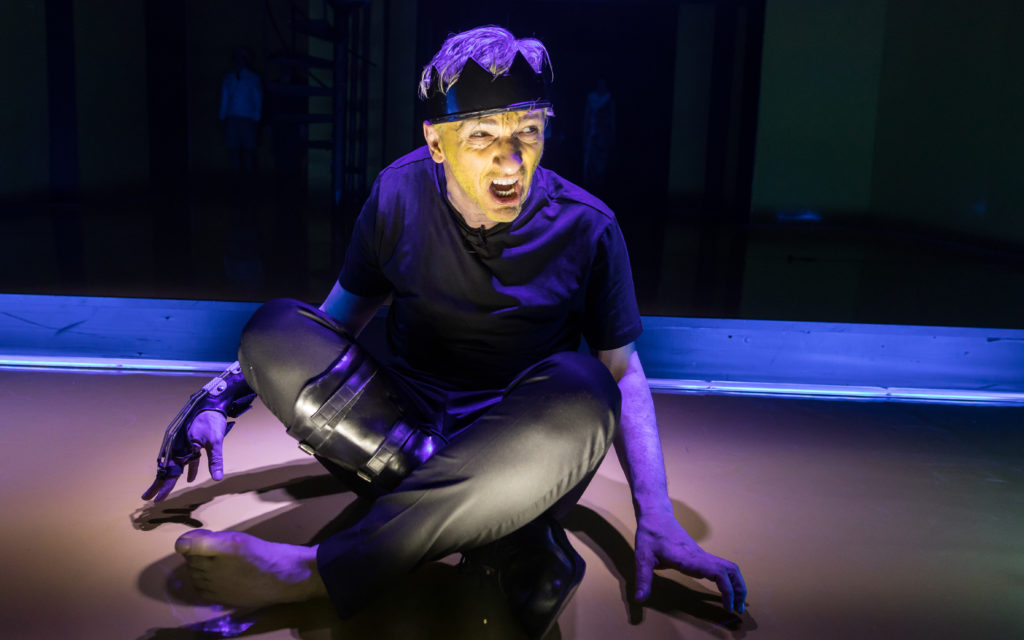
Róbert Alföldi as Richard III
Photography by Dániel Dömölky
The strength of the production is Şerban’s intelligent and mature directorial concept, executed by the clear-cut, flawless and brilliant performance of all the actors. Perhaps this becomes its weakness as well: the heart of the performance is hard to find. The audience follows with interest (but little sympathy) how this over-politicized and immoral “England” consumes itself in the murderous and bloody whirl of characters. Occasionally, it becomes obvious that “England” is a thinly veiled Hungary: the Lord Mayor of London (Zoltán Schneider) alludes to the fake “Native American” proverbs, often used by the Hungarian ruling party FIDESZ in political debates; or the references to the “Royal TV channel” echo present-day Budapest jokes on the government’s dominance in official TV channels and prime minister Viktor Orbán’s favouring of Hungary’s monarchic past.
However, these occasional winks to the contemporary Hungarian audience are overshadowed by more general concerns. Politics, symbolized by the transparent glass lectern, appearing and re-appearing downstage center, infuses and corrupts everyone and everything in this country: onstage and off-stage. The onstage characters, fuelled by their never-dying political ambition, appear rather two-dimensional. They appear persuasive and powerful in their emotions–tragic, energetic, ranting, cursing, and conspiring with tremendous energy–however, we cannot identify with their humanity, which is always limited to the present moment and situation.
For instance, the grief of Queen Elizabeth (Adél Kováts) over the deaths of her children, the young princes, is overwhelming in her passionate, almost inhuman cries and tears. However, later, in the scene when King Richard proposes to her daughter, Elizabeth appears so cold and calculating, almost flirtatious with Gloucester, that we lose our former sympathy for the bereaved mother. On this stage of politics and power, no one can remain a fully genuine and credible human being.
Şerban’s production revels in suggestive and playful doublings: 11 actors work together in a brilliant ensemble to bring to life the dark hurly-burly of political power games. They transform from one character to another virtuosically. Zsolt László’s accomplishment in doublings is a real feat: from the red-haired Georgian schoolboy of the royal heir, the future King Edward IV (who is incapable of letting go of his mobile), through the fleeting appearance as William Shakespeare himself, to the magnificent grotesque portrayal of Queen Margaret. Queen Margaret in László’s performance becomes the grotesquely genderless, menacing angel of revenge, one of the most powerful images on stage, whose curses are accompanied by achromatic musical motifs, played live by the composer Marcell Dargay.
Róbert Alföldi’s Richard captivates the audience both onstage and off-stage: his fellow-politicians as well as the civilians sitting in the darkened auditorium (which is bathed in full light at times). We become the citizens of London/England, begging Richard to accept the crown, mesmerized by a brilliant actor’s power over us. Alföldi’s Richard never relinquishes his hold on the audience; we follow him shaping and molding the onstage world. Richard is victorious in his unparalleled adaptability, flexible reasoning and morality, uttering lies that carry the semblance of truth. He is a deformed figure, but never repellent: limping through the stage in glossy black shin-guards, gesturing persuasively with hands squeezed into fashionable metal-textile wrist-braces, which cause pain to him, and also to others in friendly handshakes. He is both damaged and damaging, appealing and appalling in sleek deformity.
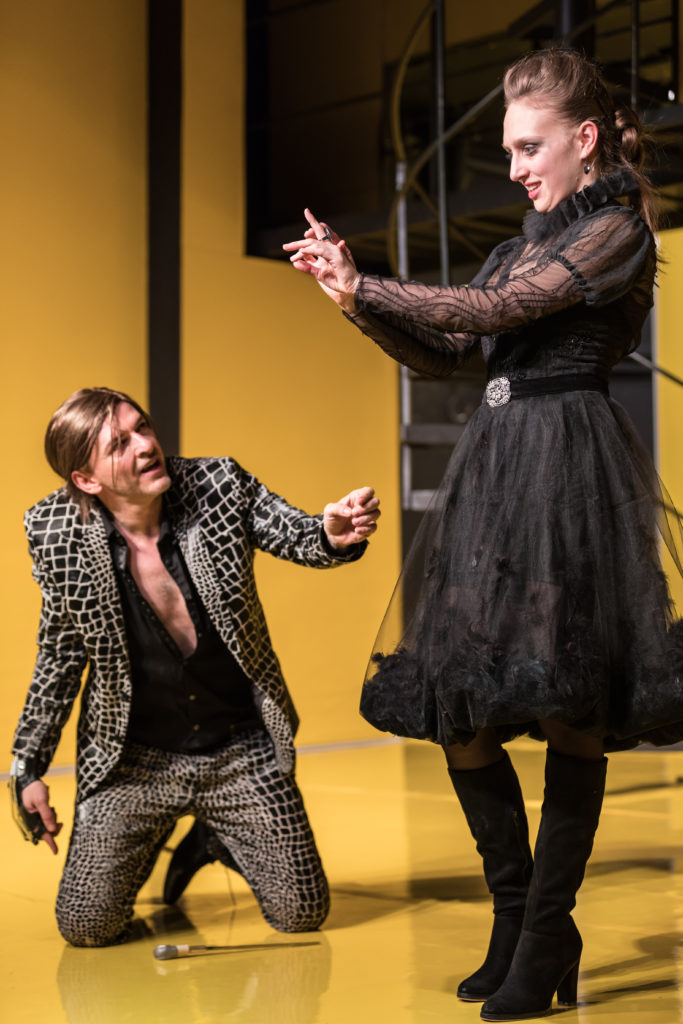
Róbert Alföldi and Eliza Sodró in Richard III
Photography by Dániel Dömölky
By the end of the performance, the audience may condemn King Richard but does not feel hatred for him, even though his personal tragedy is reflected in the scene when, already king, he faces his only enemy: himself in the mirror. Still, his last grand monologue fails to persuade us of the existence of the human inside the monster-actor. We can’t identify emotionally with Richard as a human being, which is partly due to the directorial concept. Even Gloucester’s greatest actor’s achievement, the successful seduction of Lady Anne, is presented in a key that defies any possible emotional identification with him. In Şerban’s direction, Lady Anne (Eliza Sodró) appears as politically ambitious an animal as Gloucester or the others. She is arguing with Richard passionately, shoving her mobile and Facebook comments into his face, shouting into the microphone on the lectern, fishing for the audience’s political support. This way her surrender never becomes a heartfelt tragic loss. On this politically infested stage, even the Shakespearean battle of seduction between man and woman is transformed into a fight for direct political gains. Lady Anne is not a tragic heroine but one of the petty politicians of this world. So, even her defeat and, later, her desperate attempt at self-abortion onstage result in the audience’s disgust instead of pity.
No relief is possible either emotionally or politically, the victorious Richmond does not appear at the end, his scenes are cut. We only see the dead Richard walking along the raised platform silently, above the survivors and the corpses. His mute figure may be interpreted as Richmond if we believe that only names are changed in history and not actors or political attitudes. There is no escape, no tragedy, no salvation; what remains is the power games of our own petty politicians.
The diction is based on István Vas’s 1948 translation, although it slightly–and intelligently–modernises some phrases (literary expert Péter Závada), and at times indulges in a re-structuring of some scenes and soliloquies, according to the playtext created by Andrei Şerban and Daniela Dima (dramaturg: Anikó Szűcs). The occasional topical puns and vulgarity never interfere with the overarching concept of the play, though; they only add some colorful touches.
On Şerban’s stage every word, image, and gesture remains relevant, generally and topically political, fusing 15th-century English history, a 16th-century play, and 21st-century Hungarian theatre into one meaningful whole. Even though András Pál’s Buckingham appears in modern dress, complemented with an Elizabethan ruff, and the Mohawk hairstyle of a football fan, his most important feature remains the character’s honey-tongued flattery and adaptability, thinly veiling the repressed violence underneath: the living and breathing picture of any power-hungry politician.
The meaningful simplicity of the set design, the actors’ both parodistically exaggerated and at other times highly passionate performance, accompanied by live music, work together to produce a performance that never ceases to interest the audience.
Finally, we are left with the problem of the kingdom unsettled: theatrically everything operates perfectly, but we have surrendered our principles, morals, and country for…really, for what?! Without genuine, meaningful reasons and purposes, the only reality available is the reality of desire for pure political power.
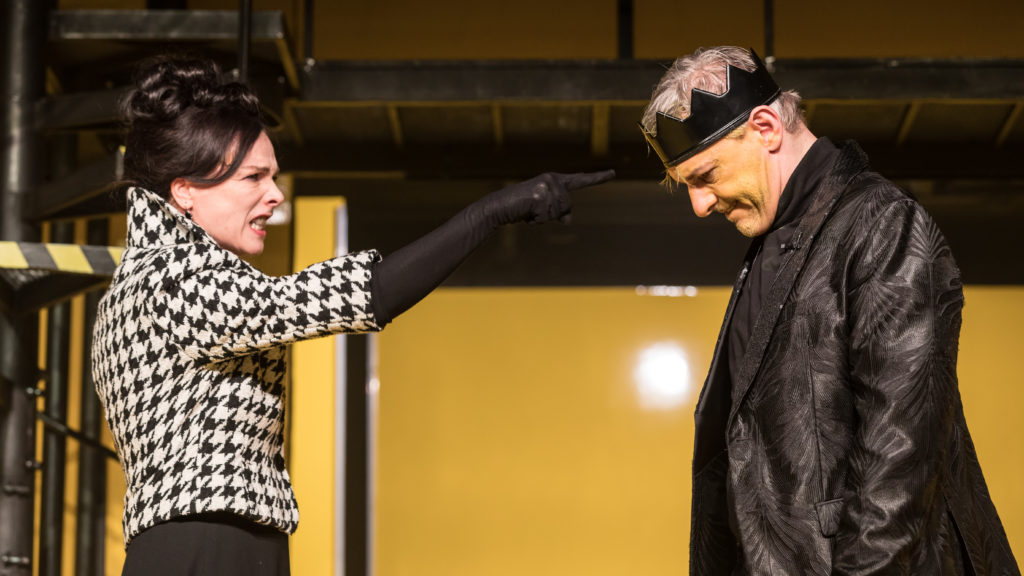
Adél Kováts and Róbert Alföldi in Richard III
Photography by Dániel Dömölky
William Shakespeare: Richard III
Premiered on February 28, 2018 at the Radnóti Theatre, Budapest.
This is an edited English version of a review by the same author (Országomat egy…miért is?) which was published in Hungarian at the Hungarian Art portal prae.hu on March 8, 2018.
https://www.prae.hu/article/10300-orszagomat-egy-miert-is/
Natália Pikli is a Senior Lecturer at the Department of English Studies, Eötvös Loránd University (ELTE), Budapest. She teaches medieval and early modern literature, contemporary English poetry and drama at ELTE, as well as Shakespearean drama and theatre as a guest lecturer at the University of Theatre and Film Arts, Budapest. She holds a PhD in Early Modern English Literature from the Eötvös Loránd University. Natália’s main research focuses on early modern popular culture and drama. She has a book published (The Prism of Laughter: Shakespeare’s “very tragical mirth”, VDM Verlag, 2009) and articles on shrew-taming discourses (Eastern Journal of European Studies / EJES, 2010) and on the early modern hobby-horse (Journal of Early Modern Studies, 2013; Shakespeare Survey, 2017). Since October 2018 she has been serving as President of the Hungarian Shakespeare Committee. She also directs English-speaking amateur productions for the university troupe Guts’n’Poses. She also publishes theatre reviews regularly, both in Hungarian and in English.
This post was written by the author in their personal capacity.The opinions expressed in this article are the author’s own and do not reflect the view of The Theatre Times, their staff or collaborators.
This post was written by Natália Pikli.
The views expressed here belong to the author and do not necessarily reflect our views and opinions.

